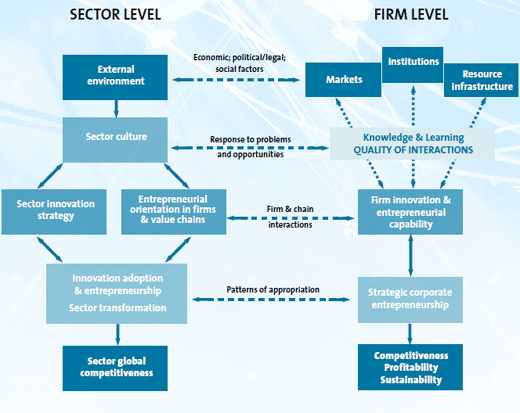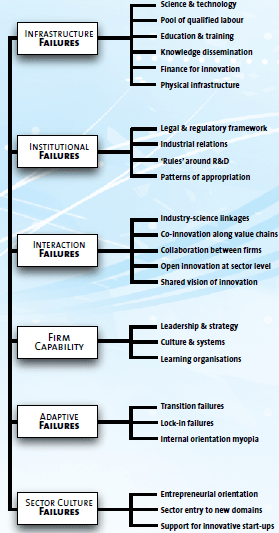



Opportunities for Scientific Knowledge Transfer to the Beef Industry
A prevailing paradigm in science research is that it should be applied for the benefit of individuals, corporations and societies, writes Ian Jenson, Meat & Livestock Australia, in the proceedings of an international conference organised by ProSafeBeef, a European Commission Research Project.In the context of the beef industry, and funding of applied research associated with beef production, processing or value adding, researchers and funding agencies have a responsibility to ensure that the research conducted will provide information that is required to fill a significant knowledge gap and furthermore, that the results will be applied to meet some industry need.
The development of research strategies and choice of subjects for research projects is beyond the scope of this paper which will concentrate on how research results can be successfully applied to industry needs, using a beef industry example.
Figure 1. Sectoral innovation and entrepreneurship system

Failures in innovation systems
The traditional approach to the dissemination of knowledge by scientists is to regard other scientists as the primary target for knowledge transfer, accomplished through publication of research reports in the academic literature. While this form of knowledge dissemination has its place, it cannot be relied upon as a means of transferring knowledge to the industry. Even if industry-oriented publications are produced, they may still not be effective in reaching an industry that is not print-oriented, generally does not value knowledge divorced from practise, may not perceive a need for the information being provided, or has an inability to make use of the information.
Transfer of knowledge must be understood in the context of the industry and may be usefully considered in the context of the “innovation system” of the industry (1,2). Innovation is considered at the level of the industry sector, of the individual firm and the interactions between the two (figure 1). The innovation system model, which is in an early stage of development, provides a framework for considering innovation failures (figure 2), not all of which may be relevant to a particular innovation scenario. Failure of innovation within a sector or within a firm is viewed, by this model, as a failure of the innovation system, which can be addressed through identification and correction of the relevant system element(s).
Figure 2. System failure analytical framework

Innovations in the Australian red meat industry
Concurrently with the development of the innovation system model, and to an extent, informing its development, the model’s developer was a senior manager with Meat & Livestock Australia (MLA), responsible for off-farm R&D. MLA is the R&D management (and marketing support) organisation for the Australian red meat industry (3). Research is conducted in a number of areas relevant to red meat processing, in cooperation with universities, government research organisations and consultants. A key role for MLA is ensuring that the industry benefits from the R&D conducted. MLA is therefore concerned, not just with the transfer of knowledge, but the application of knowledge for industry benefit. Contribution to the development of industry’s innovation strategy and evaluation of the impact of innovation are also part of MLA’s remit.
From Science to Application: the refrigeration index
The refrigeration index (RI) is a tool for assessing the microbial response to a meat chilling process based on predictive microbiology (4). The predictive microbiology underpinning the RI was developed with funding from MLA, on the basis that predictive microbiology was an emerging technology relevant to food safety, and could be applied to microorganisms relevant to the red meat sector. The industry faces many challenges every day, some of them of a technical nature. One problem, for which predictive microbiology appeared to offer some insight, was the safety of the hot boning process (removing primals from a hot/ warm carcase and chilling them).
The competent authority was concerned about the growth of pathogenic microorganisms on the relatively large surface area, that sometime chilled relatively slowly, compared to traditional carcase chilling. MLA convened an ‘expert’ panel, comprising representatives of the competent authority, technical managers of hot boning processors, the industry representative body, food safety specialists and predictive microbiologists. The purpose of this group was to determine how hot boning could be safely conducted. The panel chose to utilise an Escherichia coli predictive model, using time and temperature as the only variables (pH, water activity and lactate were set to realistic ‘worst case’ values) and defining acceptable values for the resultant predicted growth (called the refrigeration index- actually the predicted growth of E. coli, expressed as log10) based on meeting acceptable industry-wide microbiological criteria.
The competent authority then chose to apply the RI to all chilling processes, which on one hand placed a burden on the industry to verify their process control, but also offered the whole industry opportunities to innovate with their processes, in ways that were not possible when prescriptive process criteria were applied.
The success (5, 6) of this example of transferring and applying knowledge to the industry can be attributed to addressing (in an empirical, intuitive manner) a number of the failures (or potential failures) identified by the innovation system model:
Infrastructure
- good quality science in peer-reviewed journals of high standing
- initial training was provided by face-to-face training of both industry and competent authority personnel in mixed groups
- development and implementation of personnel competency standards for use of the RI, together with training materials to ensure ongoing supply of competent personnel (7)
- provision of “RI Calculator” software that was simple to use and tailored in approach (8)
Institutions
- competent authority involvement in the panel process allowed the science to be tailored to the regulatory need
- legal and regulatory framework provided through the Export Control (meat and meat products) Orders
- industry involvement in the panel ensured that the approach taken covered all scenarios and would not have unintended consequences
Interaction
- the panel process provided an informal way for industry (and regulators) to explore the science, and mould the scientific outputs to meet their needs
- the panel process ensured that the output would meet the needs of the whole industry, not just one sector
Firm Capability and Adaptability
- the compulsory nature of the Export Orders, training and provision of the RI Calculator minimised the capability and adaptability required to implement the RI as a regulatory tool. Further capability in a firm would be required to utilise the RI for process innovation.
Sector Culture
- the sector culture was sufficient to provide funding for the scientific work to commence
Implications
As noted by Pitt (1), following a similar approach with other food safety innovations has not always been (as) successful. The dimensions of innovation failure are not simply present or absent, but vary by degree as well as significance to a particular innovation. It is also likely that failures interact to make innovation in particular areas more difficult than would otherwise seem to be the case.
An implication of the sectoral innovation model for researchers and funding bodies, is that considerable effort needs to be made if there is to be successful translation of research results (knowledge) into industry practice (innovation). Innovation cannot be achieved by one party acting alone, but a concerted effort needs to be made in the required areas by the appropriate parties.
References
1. Pitt, C. A. (2007) Leading Innovation and Entrepreneurship – an action research study in the Australian red meat industry. DBA Thesis, Southern Cross University, Australia. http://epubs.scu.edu.au/cgi/viewcontent.cgi?article=1038&context=theses2. Pitt, C. & Nelle, S. International Food and Agribusiness Management Review 11(4): 1-24
3. www.mla.com.au
4. Sumner, J and Krist, K. (2002) Int. J. Food Microbiol. 73:363-366.
5. McMeekin, T. (2007) Meat Science, 77:17-27
6. http://www.mla.com.au/HeaderAndFooter/AboutMLA/Corporate+documents/Evaluation/default.htm
7. http://www.mintrac.com.au/site.php?nav=order&subnav= c&page=o_list&category=6
8. http://www.foodsafetycentre.com.au/refrigerationindex.php
July 2009



